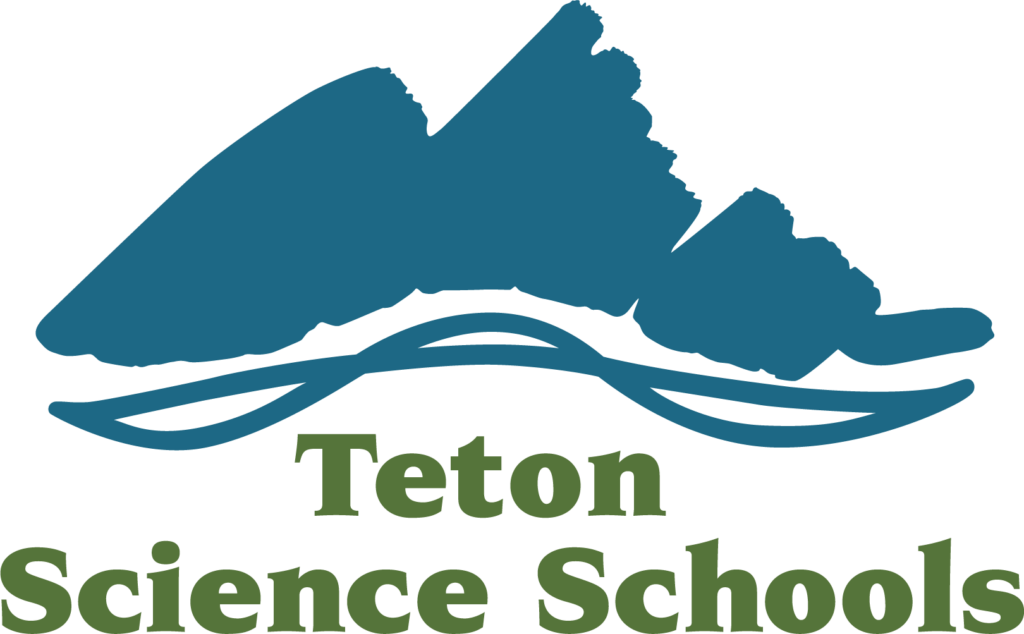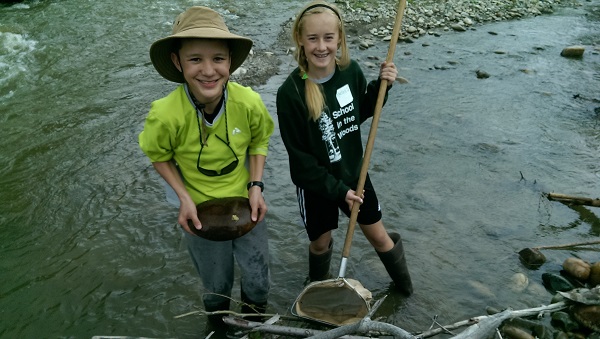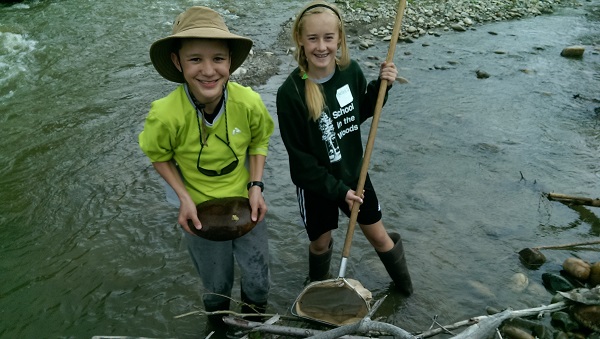
“With your partner, go explore this riparian community and see what you can find!”
With that, the twelve 4th graders disperse into the surroundings, each pair with a magnifying lens and journal. Some pairs are immediately drawn to the creek’s edge, hoping to find fish. Others take their time, closely observing the shrubs, snow, and trees that we previously passed by without a second glance. “Ooh, I think I see some bugs!” “Look at this moss! And look, there’s more here!” “Check out that tree! It has five trunks!” “I think I found some deer tracks!”
 As they are busy exploring, I steal a glance at my lesson plan. “Step 2: Exploration,” check.
As they are busy exploring, I steal a glance at my lesson plan. “Step 2: Exploration,” check.
This is the first time I am leading a whole field day, and the first time I am incorporating the Learning Cycle into my lesson plan. The Learning Cycle is a “research-based instructional model that focuses on ordering phases of an activity to support learning.” This model was shared with TSS by BEETLES (Better Environmental Education, Teaching, Learning & Expertise Sharing), a science education initiative based at the Lawrence Hall of Science at the University of California, Berkeley. Lessons based on the Learning Cycle have five phases: invitation, exploration, concept invention, application, and reflection.
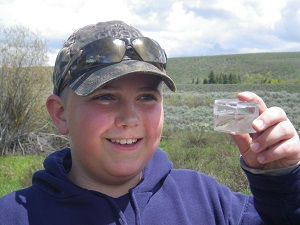 Before the current exploration phase, the students enjoyed the Invitation, a “treasure map adventure” in which students led the group to the creek’s edge using a map to a “secret spot,” a beaver lodge. In addition to the Learning Cycle, Kendall, my co-instructor, and I used David Sobel’s Design Principles for Educators, phrasing our activities in ways that evoked a child’s natural tendency towards play in nature. By structuring our day as a series of adventures in which our students could make maps and meet animal allies, our lessons on riparian communities and insects evolved into play driven by natural curiosity and the students’ interests.
Before the current exploration phase, the students enjoyed the Invitation, a “treasure map adventure” in which students led the group to the creek’s edge using a map to a “secret spot,” a beaver lodge. In addition to the Learning Cycle, Kendall, my co-instructor, and I used David Sobel’s Design Principles for Educators, phrasing our activities in ways that evoked a child’s natural tendency towards play in nature. By structuring our day as a series of adventures in which our students could make maps and meet animal allies, our lessons on riparian communities and insects evolved into play driven by natural curiosity and the students’ interests.
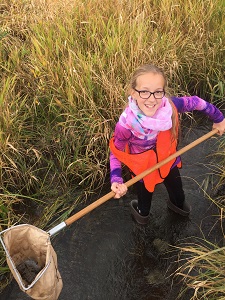 So far so good: the students seem happy and safe in their exploration. Just as I give myself a mental pat-on-the-back, I look over and see a few students standing on a bridge connecting the creek bank to a small island of rocks . . . a bridge of snow, that is, melting in the warm sunlight above the stream. Kendall and I hurry to get them off the bridge towards safer areas, and I mentally revoke my pat-on-the-back. There’s a lot to learn and remember as a new teacher, and there’s nothing as humbling as working with kids.
So far so good: the students seem happy and safe in their exploration. Just as I give myself a mental pat-on-the-back, I look over and see a few students standing on a bridge connecting the creek bank to a small island of rocks . . . a bridge of snow, that is, melting in the warm sunlight above the stream. Kendall and I hurry to get them off the bridge towards safer areas, and I mentally revoke my pat-on-the-back. There’s a lot to learn and remember as a new teacher, and there’s nothing as humbling as working with kids.
After the students explore, we reconvene as a group and sit around a large piece of paper on which I have drawn the stream. “What were some of the things you noticed and observed? Let’s add them to our map of the stream.” The students add the myriad things they observed: the beaver lodge, scat, tracks, trees, fungus, rocks, and so on. I am about to continue on with the lesson, hoping to move to the Concept Invention step by connecting their drawings with a food web, when I am interrupted: “Is it lunch time yet?” All the other hungry 4th graders chime in. “Yeah, I’m hungry!” “I’ve been hungry since breakfast!”
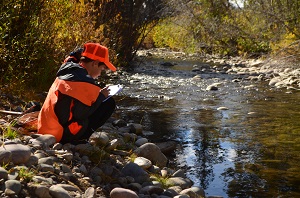 I check my watch, and indeed it is around noon, several hours since their last meal. Another lesson for me: be flexible in order to attend to the students’ needs.
I check my watch, and indeed it is around noon, several hours since their last meal. Another lesson for me: be flexible in order to attend to the students’ needs.
And so we break for lunch. Our lunchtime conversations point to the students’ extensive interests: the physics of lightsabers, the storylines behind the Mario video games, arachnids, and more. Soon it’s time for the next lesson: macroinvertebrates and insects.
“What is an insect?” I invite the students to discuss this question with a partner, and together we come up with a definition: insects have a head, thorax, and abdomen; they have three pairs of jointed legs; and they have an exoskeleton. With this student-derived concept in mind, we explore the stream to look for macroinvertebrates. Again, this exploration brings the natural curiosity and enthusiasm out of these students. “Wow, look at how many legs this one has!” “Look at how it swims!” As I help them identify their macroinvertebrates and discern them from insects, I am reminded of my own childhood, collecting insects from the backyard.
 After our exploration, we return the macroinvertebrates to the stream. It is nearing the end of the field day, so we snowshoe back to the library of the Kelly Campus to finish the lesson. There, we review the definitions of riparian and insect, and for the Application phase of the Learning Cycle, students create their own super-insect out of Play-Doh. These critters must be supremely adapted to the riparian community, and the students have no trouble inventing snorkeling mouthparts, underwater wings, and other fantastical features out of the clay. They place their critters on our big map of the stream, adding their own imaginative touch to their exploration of the riparian community.
After our exploration, we return the macroinvertebrates to the stream. It is nearing the end of the field day, so we snowshoe back to the library of the Kelly Campus to finish the lesson. There, we review the definitions of riparian and insect, and for the Application phase of the Learning Cycle, students create their own super-insect out of Play-Doh. These critters must be supremely adapted to the riparian community, and the students have no trouble inventing snorkeling mouthparts, underwater wings, and other fantastical features out of the clay. They place their critters on our big map of the stream, adding their own imaginative touch to their exploration of the riparian community.
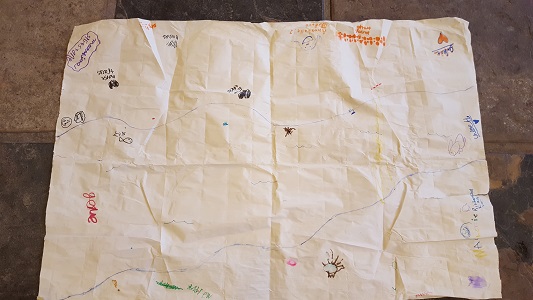 While the students reflect on how their super-insects fit in with the riparian community, I reflect on the day. Teaching often goes both ways: I teach the students about science, and they teach me about teaching. In this case, I learned that incorporating the students’ interests leads to more enjoyable and memorable learning. Sobel’s design principles were also helpful in reconnecting with youthful exploration and play. Through these students, I remembered my childhood adventures in the wilderness of my own backyard, creating treasure maps, catching and observing insects, and imagining fantasy creatures as friends. I’m grateful for the opportunity to provide this playful learning experience for these students and for the lessons and reminders they provided me in return.
While the students reflect on how their super-insects fit in with the riparian community, I reflect on the day. Teaching often goes both ways: I teach the students about science, and they teach me about teaching. In this case, I learned that incorporating the students’ interests leads to more enjoyable and memorable learning. Sobel’s design principles were also helpful in reconnecting with youthful exploration and play. Through these students, I remembered my childhood adventures in the wilderness of my own backyard, creating treasure maps, catching and observing insects, and imagining fantasy creatures as friends. I’m grateful for the opportunity to provide this playful learning experience for these students and for the lessons and reminders they provided me in return.
